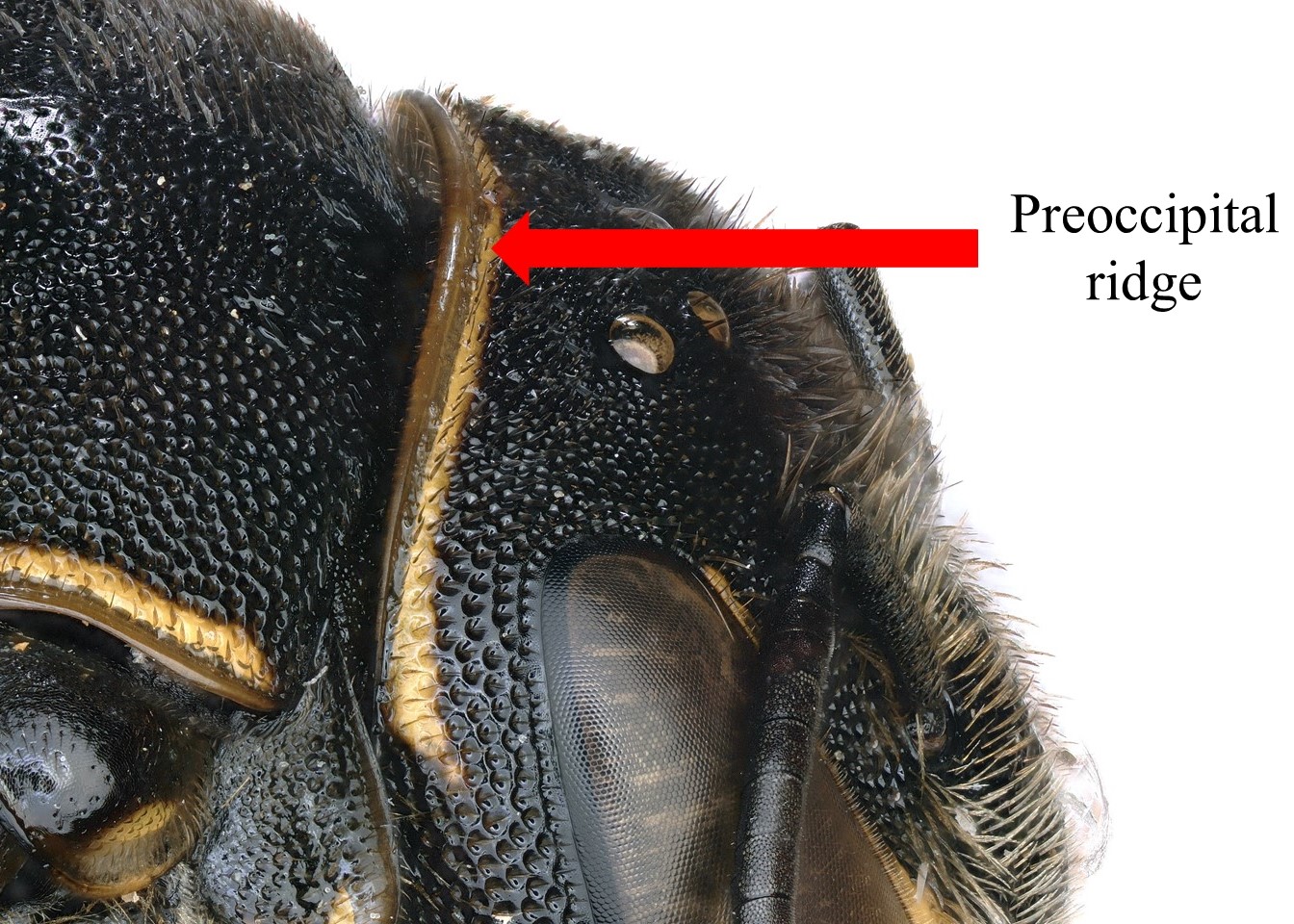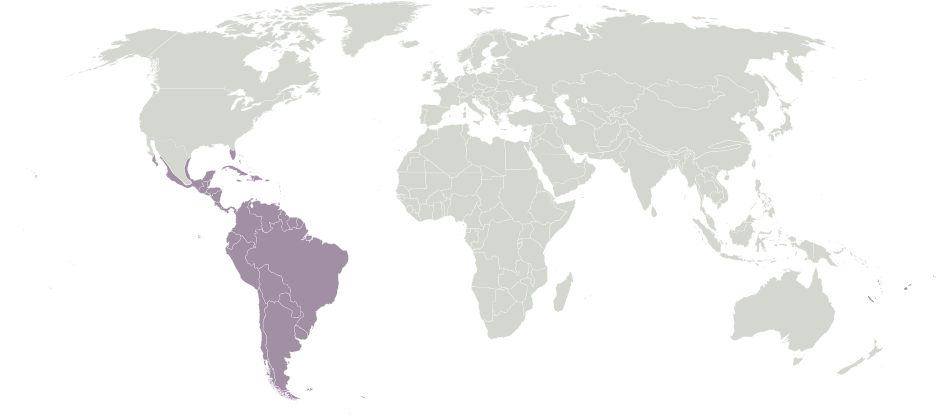Family: Megachilidae
Subfamily: Megachilinae
Tribe: Anthidiini
Genus: Hypanthidium Cockerell, 1904
Subgenera: Hypanthidium, Tylanthidium
Common name: none
Hypanthidium often has dark colored integumentintegument:
a tough, protective outer layer
with yellow maculations on their head, thorax, and abdomen (Michener 2007Michener 2007:
Michener, C.D. 2007. The Bees of the World (2nd ed.). Johns Hopkins University Press, Baltimore and London, 953 pp.). In some instances, they can be nearly entirely yellow or reddish-yellow. They have a somewhat robust, parallel-sided body, and range in body length from 7–10.5 mm (Michener 2007Michener 2007:
Michener, C.D. 2007. The Bees of the World (2nd ed.). Johns Hopkins University Press, Baltimore and London, 953 pp.).
(modified from Michener 2007Michener 2007:
Michener, C.D. 2007. The Bees of the World (2nd ed.). Johns Hopkins University Press, Baltimore and London, 953 pp. unless otherwise stated)
 without carinacarina:
without carinacarina: is large, rounded, and subtruncate. The distaldistal:
is large, rounded, and subtruncate. The distaldistal: is translucent.
is translucent.Hypanthidium may be confused with Anthodioctes that can have a similar elongate body shape and dark coloration with limited yellow markings; however, they can be differentiated by the lack of aroliaarolia:
the cushion-like pad between the tarsal claws found at the ends of some bees' legs
 and juxtantennal carinae, and lack of a carinacarina:
and juxtantennal carinae, and lack of a carinacarina:
a clearly defined ridge or keel, not necessarily high or acute; usually appears on bees as simply a raised line
between the dorsaldorsal:
in general, the upper surface
and anterioranterior:
toward the head or on the head side of a segment being described
surfaces T1T1:
the segments on the top side of the abdomen, often abbreviated when referring to a specific segment to T1, T2, T3, T4, T5, T6, or T7 in Hypanthidium (Michener 2007Michener 2007:
in Hypanthidium (Michener 2007Michener 2007:
Michener, C.D. 2007. The Bees of the World (2nd ed.). Johns Hopkins University Press, Baltimore and London, 953 pp.).
There are no known invasives.
Hypanthidium is a specialist and is dependent on Dalechampia (Euphorbiaceae) for pollen and resin for nesting, both of which are collected simultaneously (Armbruster 1984Armbruster 1984:
Armbruster, S.W. 1984. The role of resin in angiosperm pollination: ecological and chemical considerations. American Journal of Botany 71: 1149ndash;1160.).
Hypanthidium build nests out of resin, which is collected from Dalechampia (Euphorbiaceae) at the same time as the pollen (Armbruster 1984Armbruster 1984:
Armbruster, S.W. 1984. The role of resin in angiosperm pollination: ecological and chemical considerations. American Journal of Botany 71: 1149ndash;1160.). Resin is carried in small globules behind their mandibles (Armbruster and Webster 1981Armbruster and Webster 1981:
Armbruster, S.W. and G.L. Webster. 1981. Sistemas de polinizavao de duas especies simpatricas de Dalechampia (Euphorbiaceae) no Amazonas, Brasil. Acta Amazonica 11: 13ndash;17.). Hypanthidium likely use resin to seal nesting cavities, line cells, and create nest plugs, which is a behavior commonly seen in megachilid bees (Grigarick and Stange 1968Grigarick and Stange 1968:
Grigarick, A.A. and L.A. Stange. 1968. Pollen collecting bees of the Anthidiini of California (Hymenoptera: Megachilidae). Bulletin of the California Insect Survey 9: 1ndash;113.).
Hypanthidium are distributed in the NeotropicalNeotropical:
biogeographic region that includes South and Central America, the Caribbean Islands, southern Florida, and the southern Mexican lowlands region, specifically in Sonora, San Luis Potosi, and Yucatan, Mexico; Misiones, Argentina; Paraguay; Bolivia; and Amazonas, Brazil (Michener 1948Michener 1948:
region, specifically in Sonora, San Luis Potosi, and Yucatan, Mexico; Misiones, Argentina; Paraguay; Bolivia; and Amazonas, Brazil (Michener 1948Michener 1948:
Michener, C.D. 1948. The generic classification of the anthidiine bees (Hymenoptera: Megachilidae). American Museum of Natural History, New York., 2007).
Distribution map generated by Discover Life -- click on map for details, credits, and terms of use.
Armbruster, S.W. 1984. The role of resin in angiosperm pollination: ecological and chemical considerations. American Journal of Botany 71: 1149-1160.
Armbruster, S.W. and G.L. Webster. 1981. Sistemas de polinizavao de duas especies simpatricas de Dalechampia (Euphorbiaceae) no Amazonas, Brasil. Acta Amazonica 11:13-17.
Grigarick, A.A. and L.A. Stange. 1968. Pollen collecting bees of the Anthidiini of California (Hymenoptera: Megachilidae). Bulletin of the California Insect Survey 9:1-113.
Michener, C.D. 1948. The generic classification of the Anthidiine bees (Hymenoptera: Megachilidae). American Museum of Natural History, New York.
Michener, C.D. 2007. The Bees of the World. 2nd ed. Johns Hopkins University Press, Baltimore and London, 953 pp.